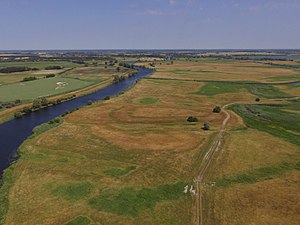Pilatsch (castle wall)
| Pilatsch | ||
|---|---|---|
|
Pilatsch photographed from the south by aerial photo |
||
| Castle type : | Niederungsburg | |
| Conservation status: | Burgstall | |
| Construction: | Timber construction | |
| Place: | Gulp | |
| Geographical location | 52 ° 43 '21 " N , 12 ° 12' 30.6" E | |
|
|
||
The Pilatsch is the castle stables of a Slavic rampart southwest of the village of Gülpe directly on the east bank of the Havel . The ground monument is located in Brandenburg a little more than a hundred meters from the state border with Saxony-Anhalt on the island of Pilatsch .
investment
The remains of the castle ramparts are on a hill about three to four meters above the surrounding level, which is said to be of natural origin. The system is roughly trapezoidal . The side lengths are about 80 by 140 meters. The plateau has a flat wall-like boundary. To the west of the main plateau, another hill is divided off by a ditch. Further remains of two parallel fortification trenches can still be seen in the south and east. Another trench completely surrounds the facility. Additional traces of attachment can also be seen in the level.
Archaeological finds from the Neolithic have been secured. However, mainly early Slavic ceramics from the early Middle Ages were found . This is how Feldberger ceramics and gray goods were found . Immediately on the bank of the Havel, a layer of fire and deep pits were found. It is assumed that the hill was built as a strong fortification in the 7th and 8th centuries. The Niederungsburg is listed under the number 50154 as "Neolithic settlement, Slavic medieval castle wall, Neolithic grave, Slavic Middle Ages settlement" as a ground monument.
Trivia
According to a local legend, a knight named Pilatus is said to have lived in the castle , who attacked passing ships on the Havel and kidnapped the boatmen. In the dungeon endure the castle had abductees until a ransom was paid. Otherwise, they would die in prison. The spirit of the knight is said to still haunt his former castle, waiting for redemption .
Individual evidence
- ↑ a b Wolfgang Bünnig: 23 The “Pilatsch” near Gülpe . In: Potsdam, Brandenburg and the Havelland , Volume 37 from the series guides to archaeological monuments in Germany. Theiss, Stuttgart 2000, ISBN 978-3-8062-1489-5 , pp. 209-210.
- ↑ List of monuments of the State of Brandenburg: District Havelland (PDF) Brandenburg State Office for Monument Preservation and State Archaeological Museum

